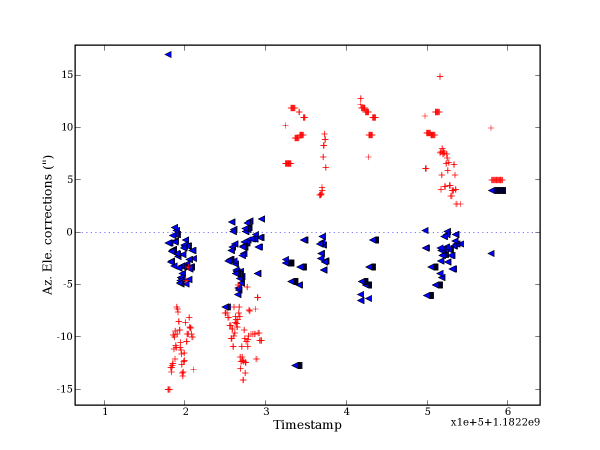|
Size: 2380
Comment:
|
← Revision 18 as of 2009-04-16 08:26:46 ⇥
Size: 2384
Comment: converted to 1.6 markup
|
| Deletions are marked like this. | Additions are marked like this. |
| Line 1: | Line 1: |
| Session of pointing monitoring the 20-25 of July 2007 [[BR]] | Session of pointing monitoring the 20-25 of July 2007 <<BR>> |
| Line 5: | Line 5: |
| [[TableOfContents]] | <<TableOfContents>> |
| Line 22: | Line 22: |
| attachment:pointingCorr20-25.06.07.png | {{attachment:pointingCorr20-25.06.07.png}} |
| Line 31: | Line 31: |
| The pointing sources are normally radio-galaxies. They can present strong variation of their radio continuum flux. The goal of this monitoring session was to check the current flux of a sub-sample of pointing sources and flag the sources with a millimetric flux too low. In the current system the Xephem is written if the flux is larger than 100 mJy. The pointing source list for Xephem has been written to follow the update of the flux measurements. [[BR]] Here is the list of the sources with a measured flux > 100 mJy and < 150 mJy: [[BR]] J1333-198 [[BR]] J2106+216 [[BR]] J1638-143 [[BR]] J2138-247 [[BR]] J2007+661 [[BR]] |
The pointing sources are normally radio-galaxies. They can present strong variation of their radio continuum flux. The goal of this monitoring session was to check the current flux of a sub-sample of pointing sources and flag the sources with a millimetric flux too low. In the current system the Xephem is written if the flux is larger than 100 mJy. The pointing source list for Xephem has been written to follow the update of the flux measurements. <<BR>> Here is the list of the sources with a measured flux > 100 mJy and < 150 mJy: <<BR>> J1333-198 <<BR>> J2106+216 <<BR>> J1638-143 <<BR>> J2138-247 <<BR>> J2007+661 <<BR>> |
Session of pointing monitoring the 20-25 of July 2007
We check the evolution of the of the flux of the pointing sources used for the bolometer observations.
Contents
Summary
We observed the pointing sources doing a pointing and an Onf-Off measurements in most of the cases.
- 100 pointing sources observed and usable for the analysis
6 sources are found to be too faint (<100 mJy): J0121+044, J0750+827, J1056+702, J1628-143, J1909+486 J1628-143, J2106+216
- 16 observations of primary and secondary calibrators were done: Uranus, K3-50A, MWC349, LKHALF234, G34.3, CW-LEO, G10.62, NGC7538, G45.1
Pointing status
The plot below shows the azimuth (blue) and elevation (red) corrections.

From that pointing session, a new pointing model was derived by JP and implemented. The parameters P2 and P7 (offsets) were changed.
Flux
The pointing sources are normally radio-galaxies. They can present strong variation of their radio continuum flux. The goal of this monitoring session was to check the current flux of a sub-sample of pointing sources and flag the sources with a millimetric flux too low. In the current system the Xephem is written if the flux is larger than 100 mJy. The pointing source list for Xephem has been written to follow the update of the flux measurements.
Here is the list of the sources with a measured flux > 100 mJy and < 150 mJy:
J1333-198
J2106+216
J1638-143
J2138-247
J2007+661
The new fluxes have been automatically added to the database.
Conclusions
- The 1 mm flux of about 100 sources was measured down to ~50 mJy with the bolometer Mambo2.
- The updated flux has allowed to give an updated picture of the pointing source flux. It allowed to update the XEphem files used for the observations with the updated flux.
Still 1611 radio sources in the DB have an unknown flux.
- A very precise pointing model was obtained thanks to the large sample observed.
- One or two similar sessions per year would allow to have an updated list of flux for the bolometer pointing source and may increase the number of new detected radio sources, especially in the sky area with a low density of pointing sources.
